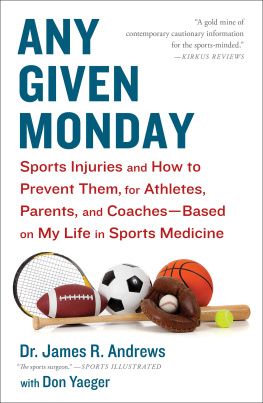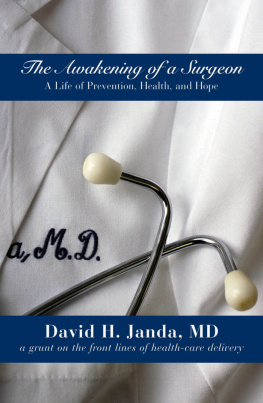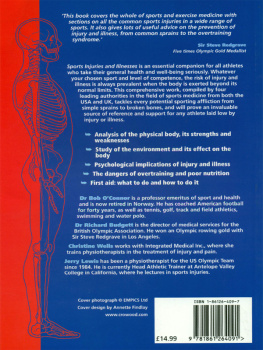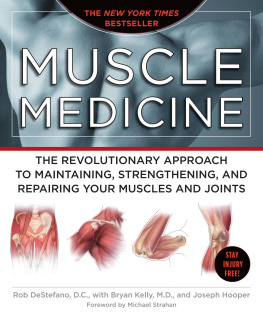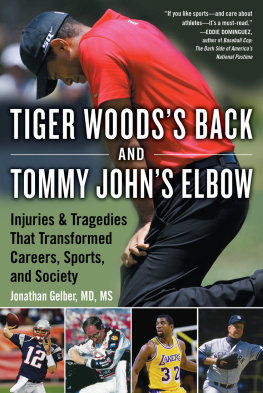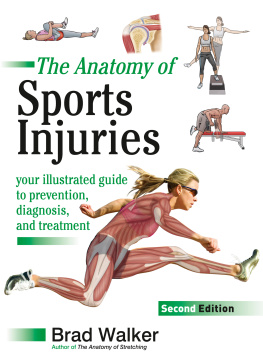Thank you for purchasing this Scribner eBook.
Join our mailing list and get updates on new releases, deals, bonus content and other great books from Scribner and Simon & Schuster.
C LICK H ERE T O S IGN U P
or visit us online to sign up at
eBookNews.SimonandSchuster.com
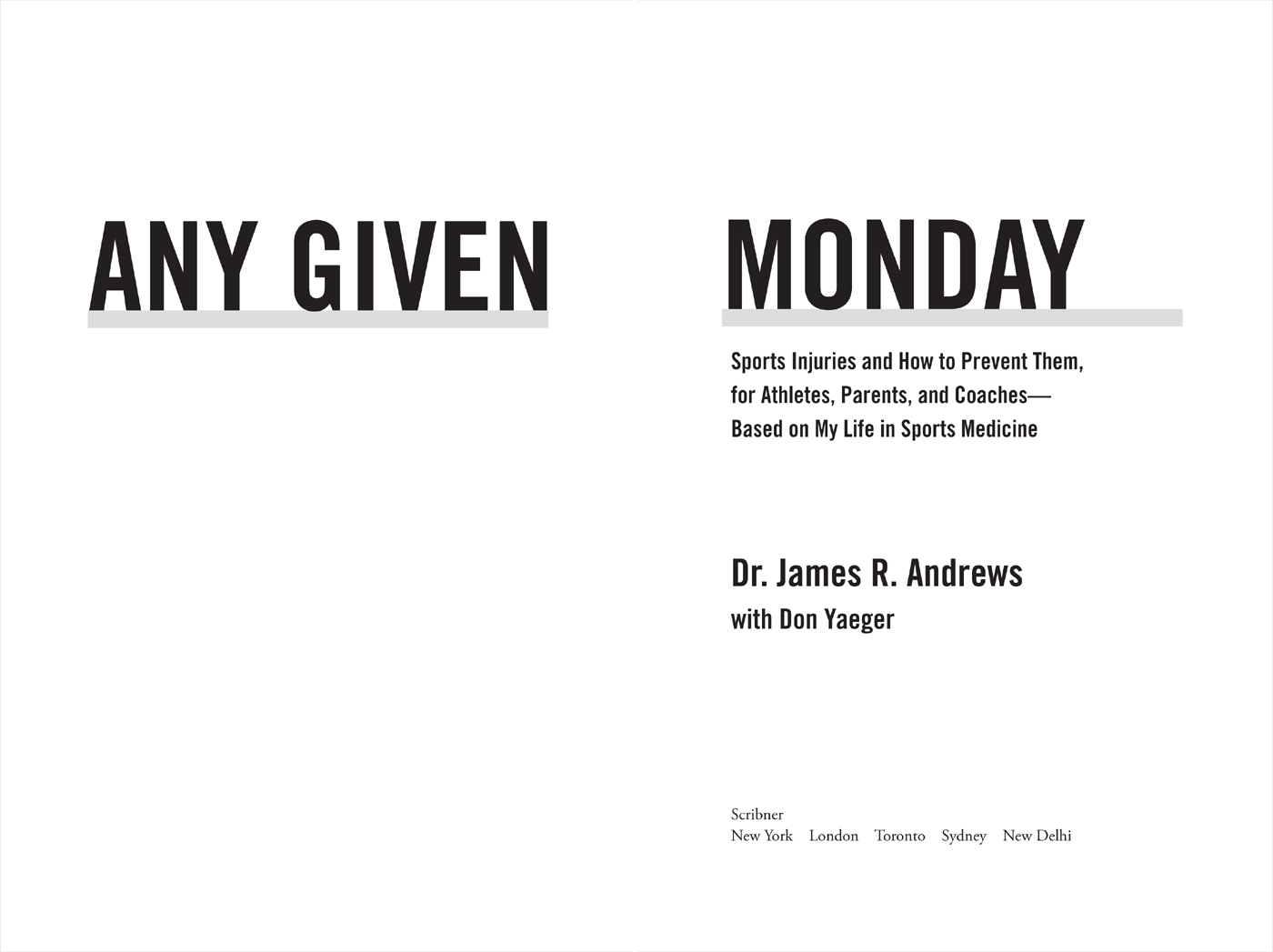
Contents
I dedicate this book to my wonderful wife, Jenelle; to all our children, Andy, Amy, Archie, Ashley, Amber, and Abby; and also to my grandkids, who have stood by me and supported me throughout my entire career. They have been instrumental in helping me sort out my priorities in life. Number one is my faith and a close second is my family. Next, my career and profession, which has been a wonderful lifetime journey.
I also dedicate the chapters on guidelines for prevention of injuries in youth sports to all the athletes whom I have been so privileged to treat and hopefully help. Being able to witness these individuals accomplish their goals not only in sports but in life in general is truly the joy and inspiration for my continued journey.
I would like to express my gratitude to my business administrator, H. Michael Immel; Lanier Johnson, the executive director of our American Sports Medicine Institute (ASMI); and all of the many other staff members, secretaries, nurses, therapists, athletic trainers, and researchers who as a team have made my life so successful and enjoyable.
From a legacy standpoint thanks so very much to all of the sports medicine fellows whom I have trained for challenging me and stimulating me to be the very best I could be. Thanks especially to Lyle Cain, MD; Jeff Dugas, MD; and Roger Ostrander, MDmy former fellows and now associatesfor all they do in establishing my continued legacy.
I also dedicate this work to Don Yaeger and his staff, who were an incredible joy to work with.
Dr. James Andrews
To my sister Nani. I admire you for all youve fought through to achieve great things. Keep the faith!
Don Yaeger
Introduction
What Is the Point of This Book?
Why, after nearly forty years of practicing medicine and preparing for inevitable retirement, would I want to write a book? And since the focus of my practice for the majority of my career has been on adults, why would I choose to write a book about youth sports injuries?
The reasons are simple but tragic. I am writing this book because it absolutely needs to be written to help curb the growing epidemic that is endangering our most athletically talented children, adolescents, and young adults. I want to make sure that parents, grandparents, coaches, trainers, and all medical personnel are taking the steps now to maximize the opportunities for the next generation of young athletes. This book is intended to do just that: to raise awareness of the most common youth sports injuries and the best ways to prevent them, while explaining the most constructive ways to build a childs potential. My hope is to educate all adults on how to protect an active child already involved in organized sports and how to select the best activities and safest exercises for a child who is looking to get physically fit.
Juvenile obesity (and the health risks brought on by the condition, such as diabetes and cardiovascular disease) has captured a great deal of media and political attention in recent years, and poor dietary choices and a more sedentary lifestyle are often to blame.
But what about the children at the other end of the spectrum: the ones who are not only physically active but also follow a strict athletic training regimen and dedicate dozens of hours every week to exercise and activity? The serious health risks facing those children are often overlooked or simply shrugged off as just part of growing up. But the truth is that youth sports injuries are an epidemic in American society, and we can do more to combat them.
Every year, more than three and a half million children under the age of fourteen require medical treatment for injuries incurred while participating in team or individual sports, and this number is on the rise. Over the past fifteen years, children have gone from being a rarity on my operating table to constituting nearly half of all my patients. More than one-fifth of all traumatic brain injuries in children are the direct result of athletic activity. Almost one-half of all sports injuries in adolescents stem from overuse, in which specific muscles and joints are damaged due to repetitive motion as part of athletic training or conditioning.
Yet despite these startling statistics, sports injuries are largely preventable, especially in children and adolescents. Even something as seemingly harmless as overuse of a joint or muscle can have a dramatic impact on future athletic ability, and even basic functions of movement and control. Both the short-term and long-term repercussions need to be considered when a child begins participating in any kind of sport.
Over the course of my nearly forty-year career, I have been the go-to surgeon for high-profile professional athletes such as Roger Clemens, Albert Pujols, Charles Barkley, Scottie Pippen, Kerri Strug, Jack Nicklaus, Raymond Floyd, Jerry Pate, Troy Aikman, Drew Brees, Brett Favre, Bo Jackson, Emmitt Smith, Terrell Owens, Sam Bradford, Matthew Stafford, and both Manning brothers, just to name a few. My goal has always been not only to return these great sports icons to the top of their game but also to help spread awareness of the causes and prevention of potentially career-ending injuries. Any Given Monday refers to the major consultation day in my clinic, when many of Americas premier athletes, fresh off broadcast TV, arrive at the Andrews Clinic in Birmingham, Alabama, or at the Andrews Institute for Orthopaedics & Sports Medicine in Gulf Breeze, Florida, for an examination of any injuries from their weekend matchups.
At least once a week, concerned parents will come into my clinic to inquire about their childs hurt shoulder, swollen elbow, or aching knee and how that injury could affect his or her athletic participation. As part of the exam, I will ask the parents to detail the childs practice schedule for the past month and year on a blackboard in the examination room so that we can look at it together. More often than not, the intensity, amount, and duration of the exercises are staggeringsometimes they are actually comparable to the training regimen of a pro. I sit down with the family and try to make them understand the potentially irreversible damage that such a schedule can do to a growing body; then we discuss better options. I want parents to seriously consider the implications of putting a twelve-year-old through the same paces as a twenty-five-year-old. Many times they have no idea as to the extent of the injury that their child is suffering; the focus of many parents and coaches is simply on pushing the child to achieve at the highest level possible for college opportunities or to gain a big break into the professional realm. What they often dont seem to realize is that if a childs body is overworked at an early age, he or she might not be able to stay in that sport long enough to make it to high school varsity, let alone to the elite level they so desperately desire. Families come to me to put their dream back together, but I want to make sure that parents and coaches understand how to prevent those dreams from shattering in the first place. Those adults have the childs best interest at heart, but most do not fully understand the risk factors at play in a specific sport.
This dangerous trend is continuing to rise year after year, while the average age of the patients on my table continues to drop. Baseball, in particular, posts some of the highest numbers in terms of serious injuries in youth sports. Recently, in a single day, I completed eight Tommy John surgeriesan operation to repair an injured elbow. Two of my patients were major league pitchers, two pitched for college teams, and four were high schoolers ranging in age from fourteen to seventeen. The following day, I took a photograph of them all together, their arms in splints and ice bags on their shoulders. It was a remarkable day because it reminded me how widespread the problem of professional-level injuries has become, even at the teenage level.
Next page
